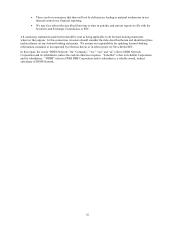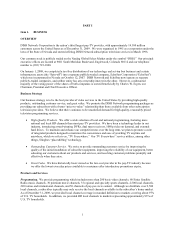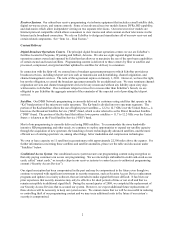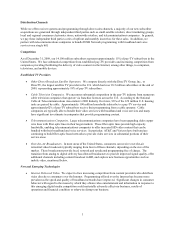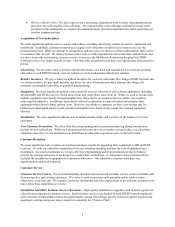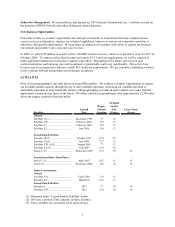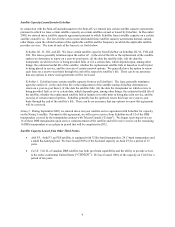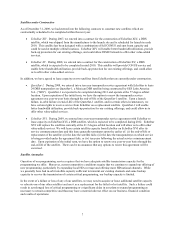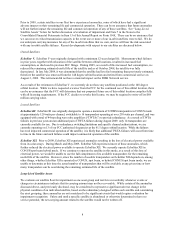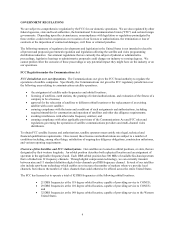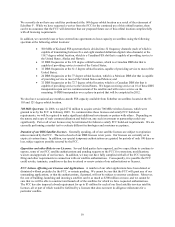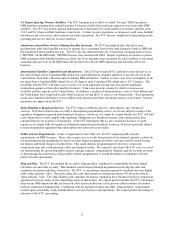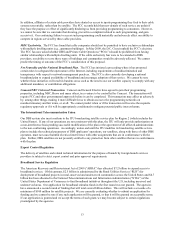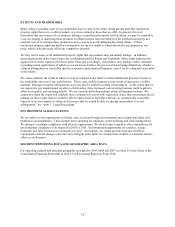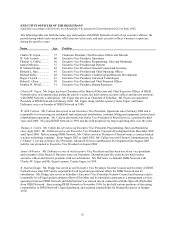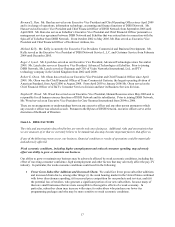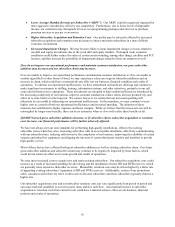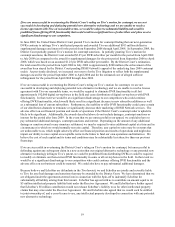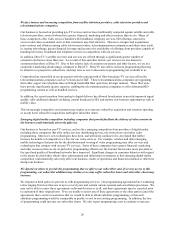Dish Network 2009 Annual Report Download - page 20
Download and view the complete annual report
Please find page 20 of the 2009 Dish Network annual report below. You can navigate through the pages in the report by either clicking on the pages listed below, or by using the keyword search tool below to find specific information within the annual report. 10
We currently do not have any satellites positioned at the 148 degree orbital location as a result of the retirement of
EchoStar V. While we have requested a waiver from the FCC for the continued use of this orbital location, there
can be no assurance that the FCC will determine that our proposed future use of this orbital location complies fully
with all licensing requirements.
In addition, we currently lease or have entered into agreements to lease capacity on satellites using the following
spectrum at the following orbital locations:
x 500 MHz of Ku-band FSS spectrum that is divided into 32 frequency channels (each of which is
capable of transmitting between five and eight standard definition digital video channels) at the
118.7 degree orbital location, which is a Canadian FSS slot that is capable of providing service to
the United States, Alaska and Hawaii;
x 32 DBS frequencies at the 129 degree orbital location, which is a Canadian DBS slot that is
capable of providing service to most of the United States;
x 32 DBS frequencies at the 61.5 degree orbital location, capable of providing service to most of the
United States;
x 24 DBS frequencies at the 77 degree orbital location, which is a Mexican DBS slot that is capable
of providing service to most of the United States and Mexico; and
x 32 DBS frequencies at the 72.7 degree orbital location, which is a Canadian DBS slot that is
capable of providing service to the United States. We began receiving service on 16 of these DBS
transponders upon service commencement of the satellite and will receive service on the
remaining 16 DBS transponders over a phase-in period that will be completed in 2012.
We also have occasional-use month-to-month FSS capacity available from EchoStar on satellites located at the 85,
105 and 121 degree orbital location.
700 MHz Spectrum. In 2008, we paid $712 million to acquire certain 700 MHz wireless licenses, which were
granted to us by the FCC in February 2009. To commercialize these licenses and satisfy FCC build-out
requirements, we will be required to make significant additional investments or partner with others. Depending on
the nature and scope of such commercialization and build-out, any such investment or partnership could vary
significantly. Part or all of our licenses may be terminated for failure to satisfy FCC build-out requirements. We are
currently performing a market test to evaluate different technologies and consumer acceptance.
Duration of our DBS Satellite Licenses. Generally speaking, all of our satellite licenses are subject to expiration
unless renewed by the FCC. The term of each of our DBS licenses is ten years. Our licenses are currently set to
expire at various times. In addition, our special temporary authorizations are granted for periods of only 180 days or
less, subject again to possible renewal by the FCC.
Opposition and other Risks to our Licenses. Several third parties have opposed, and we expect them to continue to
oppose, some of our FCC satellite authorizations and pending requests to the FCC for extensions, modifications,
waivers and approvals of our licenses. In addition, we may not have fully complied with all of the FCC reporting,
filing and other requirements in connection with our satellite authorizations. Consequently, it is possible the FCC
could revoke, terminate, condition or decline to extend or renew certain of our authorizations or licenses.
FCC Actions Affecting our Licenses and Applications. A number of our other applications have been denied or
dismissed without prejudice by the FCC, or remain pending. We cannot be sure that the FCC will grant any of our
outstanding applications, or that the authorizations, if granted, will not be subject to onerous conditions. Moreover,
the cost of building, launching and insuring a satellite can be as much as $300 million or more, and we cannot be
sure that we will be able to construct and launch all of the satellites for which we have requested authorizations.
The FCC has also imposed a bond requirement for up to $3 million for each of our fixed satellite services satellite
licenses, all or part of which would be forfeited by a licensee that does not meet its diligence milestones for a
particular satellite.


